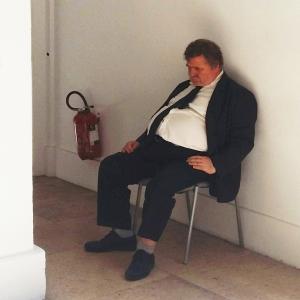
NULLA, Guggenheim
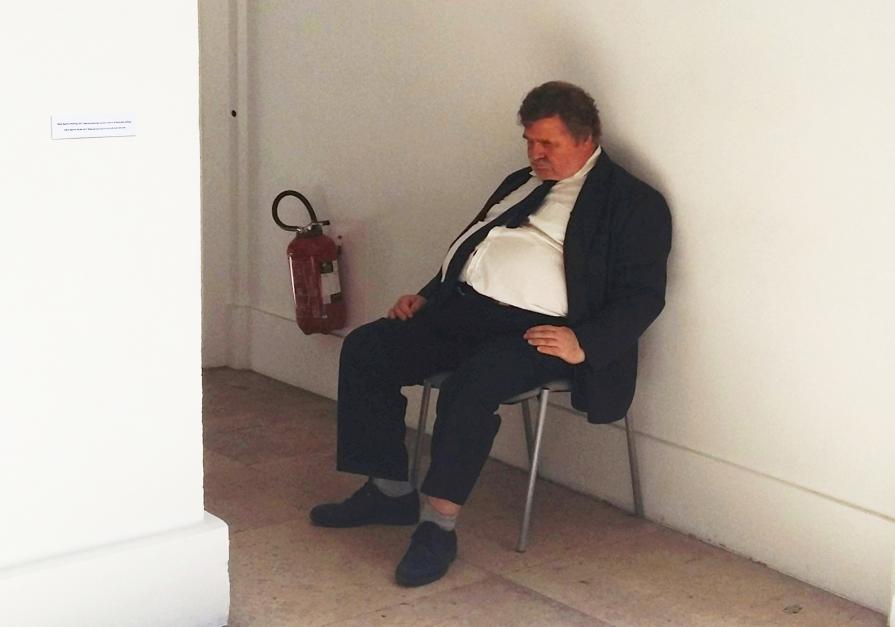
Nulla ( Nothing/ The Emptiness) ‘Nulla’ scares, ‘ Nulla’ opposed to being, it is all the things that it is not, and this is what scares, frightens. Mankind created the idea of nothing and gave it a name. Researches, scientists, people of faith spent all their lives in the desperate and distressing research of a link between nothing and reality. It is exactly with this idea that Dario Agrimi’s work of art ‘Nulla’ was conceived, to shape the shapeless, to associate a concept to the Nulla, overturning the conceptual logic in the term itself. We could have Nulla in our pockets, Nulla to say, think that there is Nulla more to do, but the effort that the author requires from us is way bigger that the concept of ‘absence’ or ‘neglect’, because it requires the ability of removing everything, thoughts included. Agrimi, with his work of art, allows the viewer to experience the Nulla, to ask himself what it is, without any influences derived from an artistic perception, without well-defined shapes or edges, without weight or specific consistency. The viewer is in front of the Nulla, he faces himself, his own corporeal experience, he looks at an unconditional possibility imposed by the impossibility itself of human kind’s absolute silence. We can experience, therefore, according to the artist, the presence as well as the absence and with it the maximum expressivity of the act, emerges out of emptiness, from an extremism of ‘Nulla’ that is the only element able to evoke the mystery of existence. When art neglects itself it expresses with the maximum intensity the sense and shape of its own origin, in that Nulla where everything is possible. ‘Nulla’ is an artwork exhibited at: Palazzo Strozzi (Florence, Italy, 2016); Mambo (Bologna, Italy, 2017); Artefiera (Bologna, Italy, 2017); Biennale di Venezia (Venice, Italy, 2017); Palazzo Grassi (Venice, Italy, 2017); Guggenheim Museum (Venice, Italy, 2017); Saatchi Gallery (London, UK, 2017); Tate Modern (London, UK, 2015); Tate Britain (London, UK, 2017); British Museum (London, UK, 2017); Louvre (Paris, France, 2017); Musée D’Orsay (Paris, France, 2017); Museo Blanco (Bali, Indonesia, 2016). The singularity, however, is that in all these sites a proper artistic operation was realised, with the main intent of completely overturn the artwork exhibitive sense. Agrimi, indeed, carrying out the performative act of pinning explicatory captions on the empty walls of the exhibitions, without any permission given by curators of these world-famous museums and galleries, shaped the undefined, forcing the curious viewer to ask himself questions about ‘Nulla’. The real revolution of this work is that today, without an actual acknowledgment, ‘Nulla’ is present in every museum and gallery of the world, but moreover, it is present in every place because is the concept of nothing itself that will bring every viewer back to Agrimi’s illumination. The latter is the person who now owns the deepest and most conceptual meaning of the term and who decided to dedicate one of his artworks to ‘Nulla’.
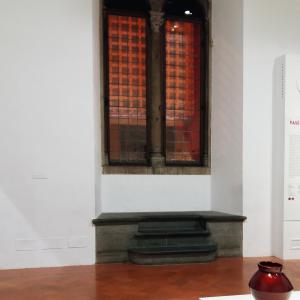
NULLA, Palazzo Strozzi

Nulla ( Nothing/ The Emptiness) ‘Nulla’ scares, ‘ Nulla’ opposed to being, it is all the things that it is not, and this is what scares, frightens. Mankind created the idea of nothing and gave it a name. Researches, scientists, people of faith spent all their lives in the desperate and distressing research of a link between nothing and reality. It is exactly with this idea that Dario Agrimi’s work of art ‘Nulla’ was conceived, to shape the shapeless, to associate a concept to the Nulla, overturning the conceptual logic in the term itself. We could have Nulla in our pockets, Nulla to say, think that there is Nulla more to do, but the effort that the author requires from us is way bigger that the concept of ‘absence’ or ‘neglect’, because it requires the ability of removing everything, thoughts included. Agrimi, with his work of art, allows the viewer to experience the Nulla, to ask himself what it is, without any influences derived from an artistic perception, without well-defined shapes or edges, without weight or specific consistency. The viewer is in front of the Nulla, he faces himself, his own corporeal experience, he looks at an unconditional possibility imposed by the impossibility itself of human kind’s absolute silence. We can experience, therefore, according to the artist, the presence as well as the absence and with it the maximum expressivity of the act, emerges out of emptiness, from an extremism of ‘Nulla’ that is the only element able to evoke the mystery of existence. When art neglects itself it expresses with the maximum intensity the sense and shape of its own origin, in that Nulla where everything is possible. ‘Nulla’ is an artwork exhibited at: Palazzo Strozzi (Florence, Italy, 2016); Mambo (Bologna, Italy, 2017); Artefiera (Bologna, Italy, 2017); Biennale di Venezia (Venice, Italy, 2017); Palazzo Grassi (Venice, Italy, 2017); Guggenheim Museum (Venice, Italy, 2017); Saatchi Gallery (London, UK, 2017); Tate Modern (London, UK, 2015); Tate Britain (London, UK, 2017); British Museum (London, UK, 2017); Louvre (Paris, France, 2017); Musée D’Orsay (Paris, France, 2017); Museo Blanco (Bali, Indonesia, 2016). The singularity, however, is that in all these sites a proper artistic operation was realised, with the main intent of completely overturn the artwork exhibitive sense. Agrimi, indeed, carrying out the performative act of pinning explicatory captions on the empty walls of the exhibitions, without any permission given by curators of these world-famous museums and galleries, shaped the undefined, forcing the curious viewer to ask himself questions about ‘Nulla’. The real revolution of this work is that today, without an actual acknowledgment, ‘Nulla’ is present in every museum and gallery of the world, but moreover, it is present in every place because is the concept of nothing itself that will bring every viewer back to Agrimi’s illumination. The latter is the person who now owns the deepest and most conceptual meaning of the term and who decided to dedicate one of his artworks to ‘Nulla’.
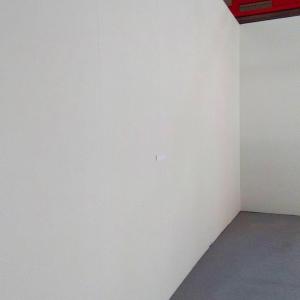
NULLA, Artefiera Bologna
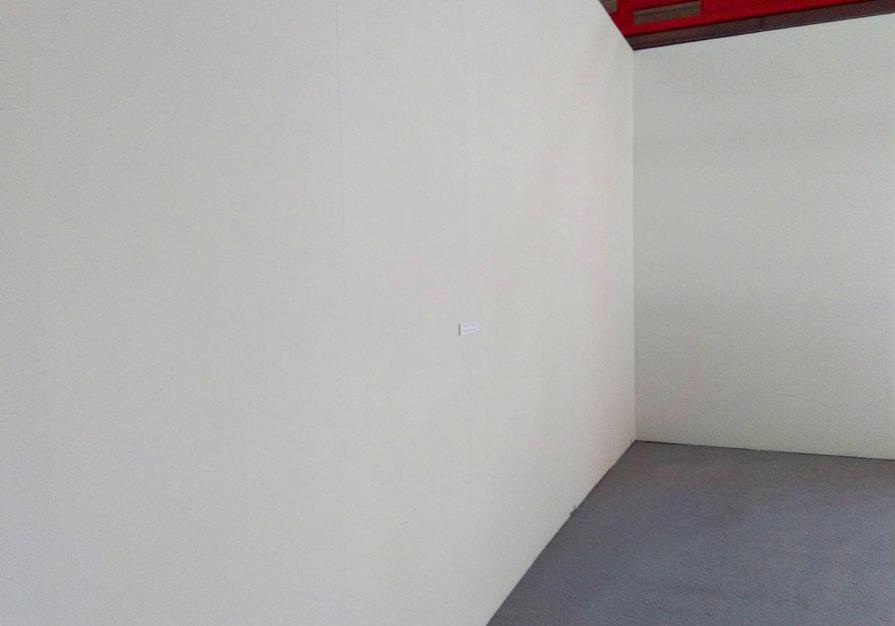
Nulla ( Nothing/ The Emptiness) ‘Nulla’ scares, ‘ Nulla’ opposed to being, it is all the things that it is not, and this is what scares, frightens. Mankind created the idea of nothing and gave it a name. Researches, scientists, people of faith spent all their lives in the desperate and distressing research of a link between nothing and reality. It is exactly with this idea that Dario Agrimi’s work of art ‘Nulla’ was conceived, to shape the shapeless, to associate a concept to the Nulla, overturning the conceptual logic in the term itself. We could have Nulla in our pockets, Nulla to say, think that there is Nulla more to do, but the effort that the author requires from us is way bigger that the concept of ‘absence’ or ‘neglect’, because it requires the ability of removing everything, thoughts included. Agrimi, with his work of art, allows the viewer to experience the Nulla, to ask himself what it is, without any influences derived from an artistic perception, without well-defined shapes or edges, without weight or specific consistency. The viewer is in front of the Nulla, he faces himself, his own corporeal experience, he looks at an unconditional possibility imposed by the impossibility itself of human kind’s absolute silence. We can experience, therefore, according to the artist, the presence as well as the absence and with it the maximum expressivity of the act, emerges out of emptiness, from an extremism of ‘Nulla’ that is the only element able to evoke the mystery of existence. When art neglects itself it expresses with the maximum intensity the sense and shape of its own origin, in that Nulla where everything is possible. ‘Nulla’ is an artwork exhibited at: Palazzo Strozzi (Florence, Italy, 2016); Mambo (Bologna, Italy, 2017); Artefiera (Bologna, Italy, 2017); Biennale di Venezia (Venice, Italy, 2017); Palazzo Grassi (Venice, Italy, 2017); Guggenheim Museum (Venice, Italy, 2017); Saatchi Gallery (London, UK, 2017); Tate Modern (London, UK, 2015); Tate Britain (London, UK, 2017); British Museum (London, UK, 2017); Louvre (Paris, France, 2017); Musée D’Orsay (Paris, France, 2017); Museo Blanco (Bali, Indonesia, 2016). The singularity, however, is that in all these sites a proper artistic operation was realised, with the main intent of completely overturn the artwork exhibitive sense. Agrimi, indeed, carrying out the performative act of pinning explicatory captions on the empty walls of the exhibitions, without any permission given by curators of these world-famous museums and galleries, shaped the undefined, forcing the curious viewer to ask himself questions about ‘Nulla’. The real revolution of this work is that today, without an actual acknowledgment, ‘Nulla’ is present in every museum and gallery of the world, but moreover, it is present in every place because is the concept of nothing itself that will bring every viewer back to Agrimi’s illumination. The latter is the person who now owns the deepest and most conceptual meaning of the term and who decided to dedicate one of his artworks to ‘Nulla’.
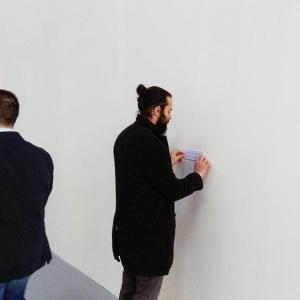
NULLa,Tate Modern
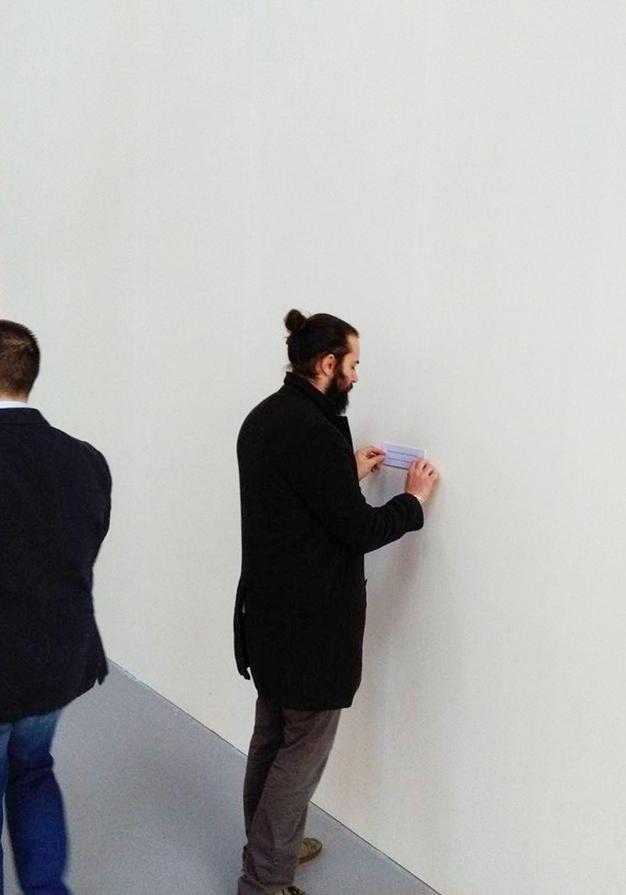
Nulla ( Nothing/ The Emptiness) ‘Nulla’ scares, ‘ Nulla’ opposed to being, it is all the things that it is not, and this is what scares, frightens. Mankind created the idea of nothing and gave it a name. Researches, scientists, people of faith spent all their lives in the desperate and distressing research of a link between nothing and reality. It is exactly with this idea that Dario Agrimi’s work of art ‘Nulla’ was conceived, to shape the shapeless, to associate a concept to the Nulla, overturning the conceptual logic in the term itself. We could have Nulla in our pockets, Nulla to say, think that there is Nulla more to do, but the effort that the author requires from us is way bigger that the concept of ‘absence’ or ‘neglect’, because it requires the ability of removing everything, thoughts included. Agrimi, with his work of art, allows the viewer to experience the Nulla, to ask himself what it is, without any influences derived from an artistic perception, without well-defined shapes or edges, without weight or specific consistency. The viewer is in front of the Nulla, he faces himself, his own corporeal experience, he looks at an unconditional possibility imposed by the impossibility itself of human kind’s absolute silence. We can experience, therefore, according to the artist, the presence as well as the absence and with it the maximum expressivity of the act, emerges out of emptiness, from an extremism of ‘Nulla’ that is the only element able to evoke the mystery of existence. When art neglects itself it expresses with the maximum intensity the sense and shape of its own origin, in that Nulla where everything is possible. ‘Nulla’ is an artwork exhibited at: Palazzo Strozzi (Florence, Italy, 2016); Mambo (Bologna, Italy, 2017); Artefiera (Bologna, Italy, 2017); Biennale di Venezia (Venice, Italy, 2017); Palazzo Grassi (Venice, Italy, 2017); Guggenheim Museum (Venice, Italy, 2017); Saatchi Gallery (London, UK, 2017); Tate Modern (London, UK, 2015); Tate Britain (London, UK, 2017); British Museum (London, UK, 2017); Louvre (Paris, France, 2017); Musée D’Orsay (Paris, France, 2017); Museo Blanco (Bali, Indonesia, 2016). The singularity, however, is that in all these sites a proper artistic operation was realised, with the main intent of completely overturn the artwork exhibitive sense. Agrimi, indeed, carrying out the performative act of pinning explicatory captions on the empty walls of the exhibitions, without any permission given by curators of these world-famous museums and galleries, shaped the undefined, forcing the curious viewer to ask himself questions about ‘Nulla’. The real revolution of this work is that today, without an actual acknowledgment, ‘Nulla’ is present in every museum and gallery of the world, but moreover, it is present in every place because is the concept of nothing itself that will bring every viewer back to Agrimi’s illumination. The latter is the person who now owns the deepest and most conceptual meaning of the term and who decided to dedicate one of his artworks to ‘Nulla’.

NULLA, Palazzo Grassi

Nulla ( Nothing/ The Emptiness) ‘Nulla’ scares, ‘ Nulla’ opposed to being, it is all the things that it is not, and this is what scares, frightens. Mankind created the idea of nothing and gave it a name. Researches, scientists, people of faith spent all their lives in the desperate and distressing research of a link between nothing and reality. It is exactly with this idea that Dario Agrimi’s work of art ‘Nulla’ was conceived, to shape the shapeless, to associate a concept to the Nulla, overturning the conceptual logic in the term itself. We could have Nulla in our pockets, Nulla to say, think that there is Nulla more to do, but the effort that the author requires from us is way bigger that the concept of ‘absence’ or ‘neglect’, because it requires the ability of removing everything, thoughts included. Agrimi, with his work of art, allows the viewer to experience the Nulla, to ask himself what it is, without any influences derived from an artistic perception, without well-defined shapes or edges, without weight or specific consistency. The viewer is in front of the Nulla, he faces himself, his own corporeal experience, he looks at an unconditional possibility imposed by the impossibility itself of human kind’s absolute silence. We can experience, therefore, according to the artist, the presence as well as the absence and with it the maximum expressivity of the act, emerges out of emptiness, from an extremism of ‘Nulla’ that is the only element able to evoke the mystery of existence. When art neglects itself it expresses with the maximum intensity the sense and shape of its own origin, in that Nulla where everything is possible. ‘Nulla’ is an artwork exhibited at: Palazzo Strozzi (Florence, Italy, 2016); Mambo (Bologna, Italy, 2017); Artefiera (Bologna, Italy, 2017); Biennale di Venezia (Venice, Italy, 2017); Palazzo Grassi (Venice, Italy, 2017); Guggenheim Museum (Venice, Italy, 2017); Saatchi Gallery (London, UK, 2017); Tate Modern (London, UK, 2015); Tate Britain (London, UK, 2017); British Museum (London, UK, 2017); Louvre (Paris, France, 2017); Musée D’Orsay (Paris, France, 2017); Museo Blanco (Bali, Indonesia, 2016). The singularity, however, is that in all these sites a proper artistic operation was realised, with the main intent of completely overturn the artwork exhibitive sense. Agrimi, indeed, carrying out the performative act of pinning explicatory captions on the empty walls of the exhibitions, without any permission given by curators of these world-famous museums and galleries, shaped the undefined, forcing the curious viewer to ask himself questions about ‘Nulla’. The real revolution of this work is that today, without an actual acknowledgment, ‘Nulla’ is present in every museum and gallery of the world, but moreover, it is present in every place because is the concept of nothing itself that will bring every viewer back to Agrimi’s illumination. The latter is the person who now owns the deepest and most conceptual meaning of the term and who decided to dedicate one of his artworks to ‘Nulla’.

NULLA, Louvre

Nulla ( Nothing/ The Emptiness) ‘Nulla’ scares, ‘ Nulla’ opposed to being, it is all the things that it is not, and this is what scares, frightens. Mankind created the idea of nothing and gave it a name. Researches, scientists, people of faith spent all their lives in the desperate and distressing research of a link between nothing and reality. It is exactly with this idea that Dario Agrimi’s work of art ‘Nulla’ was conceived, to shape the shapeless, to associate a concept to the Nulla, overturning the conceptual logic in the term itself. We could have Nulla in our pockets, Nulla to say, think that there is Nulla more to do, but the effort that the author requires from us is way bigger that the concept of ‘absence’ or ‘neglect’, because it requires the ability of removing everything, thoughts included. Agrimi, with his work of art, allows the viewer to experience the Nulla, to ask himself what it is, without any influences derived from an artistic perception, without well-defined shapes or edges, without weight or specific consistency. The viewer is in front of the Nulla, he faces himself, his own corporeal experience, he looks at an unconditional possibility imposed by the impossibility itself of human kind’s absolute silence. We can experience, therefore, according to the artist, the presence as well as the absence and with it the maximum expressivity of the act, emerges out of emptiness, from an extremism of ‘Nulla’ that is the only element able to evoke the mystery of existence. When art neglects itself it expresses with the maximum intensity the sense and shape of its own origin, in that Nulla where everything is possible. ‘Nulla’ is an artwork exhibited at: Palazzo Strozzi (Florence, Italy, 2016); Mambo (Bologna, Italy, 2017); Artefiera (Bologna, Italy, 2017); Biennale di Venezia (Venice, Italy, 2017); Palazzo Grassi (Venice, Italy, 2017); Guggenheim Museum (Venice, Italy, 2017); Saatchi Gallery (London, UK, 2017); Tate Modern (London, UK, 2015); Tate Britain (London, UK, 2017); British Museum (London, UK, 2017); Louvre (Paris, France, 2017); Musée D’Orsay (Paris, France, 2017); Museo Blanco (Bali, Indonesia, 2016). The singularity, however, is that in all these sites a proper artistic operation was realised, with the main intent of completely overturn the artwork exhibitive sense. Agrimi, indeed, carrying out the performative act of pinning explicatory captions on the empty walls of the exhibitions, without any permission given by curators of these world-famous museums and galleries, shaped the undefined, forcing the curious viewer to ask himself questions about ‘Nulla’. The real revolution of this work is that today, without an actual acknowledgment, ‘Nulla’ is present in every museum and gallery of the world, but moreover, it is present in every place because is the concept of nothing itself that will bring every viewer back to Agrimi’s illumination. The latter is the person who now owns the deepest and most conceptual meaning of the term and who decided to dedicate one of his artworks to ‘Nulla’.
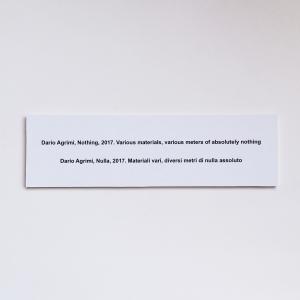
NULLA
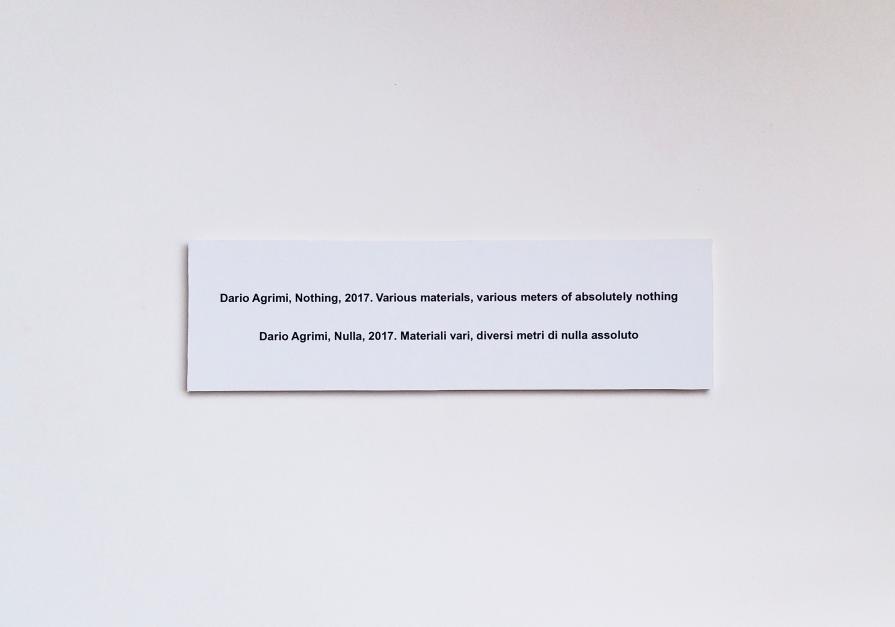
Nulla ( Nothing/ The Emptiness) ‘Nulla’ scares, ‘ Nulla’ opposed to being, it is all the things that it is not, and this is what scares, frightens. Mankind created the idea of nothing and gave it a name. Researches, scientists, people of faith spent all their lives in the desperate and distressing research of a link between nothing and reality. It is exactly with this idea that Dario Agrimi’s work of art ‘Nulla’ was conceived, to shape the shapeless, to associate a concept to the Nulla, overturning the conceptual logic in the term itself. We could have Nulla in our pockets, Nulla to say, think that there is Nulla more to do, but the effort that the author requires from us is way bigger that the concept of ‘absence’ or ‘neglect’, because it requires the ability of removing everything, thoughts included. Agrimi, with his work of art, allows the viewer to experience the Nulla, to ask himself what it is, without any influences derived from an artistic perception, without well-defined shapes or edges, without weight or specific consistency. The viewer is in front of the Nulla, he faces himself, his own corporeal experience, he looks at an unconditional possibility imposed by the impossibility itself of human kind’s absolute silence. We can experience, therefore, according to the artist, the presence as well as the absence and with it the maximum expressivity of the act, emerges out of emptiness, from an extremism of ‘Nulla’ that is the only element able to evoke the mystery of existence. When art neglects itself it expresses with the maximum intensity the sense and shape of its own origin, in that Nulla where everything is possible. ‘Nulla’ is an artwork exhibited at: Palazzo Strozzi (Florence, Italy, 2016); Mambo (Bologna, Italy, 2017); Artefiera (Bologna, Italy, 2017); Biennale di Venezia (Venice, Italy, 2017); Palazzo Grassi (Venice, Italy, 2017); Guggenheim Museum (Venice, Italy, 2017); Saatchi Gallery (London, UK, 2017); Tate Modern (London, UK, 2015); Tate Britain (London, UK, 2017); British Museum (London, UK, 2017); Louvre (Paris, France, 2017); Musée D’Orsay (Paris, France, 2017); Museo Blanco (Bali, Indonesia, 2016). The singularity, however, is that in all these sites a proper artistic operation was realised, with the main intent of completely overturn the artwork exhibitive sense. Agrimi, indeed, carrying out the performative act of pinning explicatory captions on the empty walls of the exhibitions, without any permission given by curators of these world-famous museums and galleries, shaped the undefined, forcing the curious viewer to ask himself questions about ‘Nulla’. The real revolution of this work is that today, without an actual acknowledgment, ‘Nulla’ is present in every museum and gallery of the world, but moreover, it is present in every place because is the concept of nothing itself that will bring every viewer back to Agrimi’s illumination. The latter is the person who now owns the deepest and most conceptual meaning of the term and who decided to dedicate one of his artworks to ‘Nulla’.

NULLA, Saatchi

Nulla ( Nothing/ The Emptiness) ‘Nulla’ scares, ‘ Nulla’ opposed to being, it is all the things that it is not, and this is what scares, frightens. Mankind created the idea of nothing and gave it a name. Researches, scientists, people of faith spent all their lives in the desperate and distressing research of a link between nothing and reality. It is exactly with this idea that Dario Agrimi’s work of art ‘Nulla’ was conceived, to shape the shapeless, to associate a concept to the Nulla, overturning the conceptual logic in the term itself. We could have Nulla in our pockets, Nulla to say, think that there is Nulla more to do, but the effort that the author requires from us is way bigger that the concept of ‘absence’ or ‘neglect’, because it requires the ability of removing everything, thoughts included. Agrimi, with his work of art, allows the viewer to experience the Nulla, to ask himself what it is, without any influences derived from an artistic perception, without well-defined shapes or edges, without weight or specific consistency. The viewer is in front of the Nulla, he faces himself, his own corporeal experience, he looks at an unconditional possibility imposed by the impossibility itself of human kind’s absolute silence. We can experience, therefore, according to the artist, the presence as well as the absence and with it the maximum expressivity of the act, emerges out of emptiness, from an extremism of ‘Nulla’ that is the only element able to evoke the mystery of existence. When art neglects itself it expresses with the maximum intensity the sense and shape of its own origin, in that Nulla where everything is possible. ‘Nulla’ is an artwork exhibited at: Palazzo Strozzi (Florence, Italy, 2016); Mambo (Bologna, Italy, 2017); Artefiera (Bologna, Italy, 2017); Biennale di Venezia (Venice, Italy, 2017); Palazzo Grassi (Venice, Italy, 2017); Guggenheim Museum (Venice, Italy, 2017); Saatchi Gallery (London, UK, 2017); Tate Modern (London, UK, 2015); Tate Britain (London, UK, 2017); British Museum (London, UK, 2017); Louvre (Paris, France, 2017); Musée D’Orsay (Paris, France, 2017); Museo Blanco (Bali, Indonesia, 2016). The singularity, however, is that in all these sites a proper artistic operation was realised, with the main intent of completely overturn the artwork exhibitive sense. Agrimi, indeed, carrying out the performative act of pinning explicatory captions on the empty walls of the exhibitions, without any permission given by curators of these world-famous museums and galleries, shaped the undefined, forcing the curious viewer to ask himself questions about ‘Nulla’. The real revolution of this work is that today, without an actual acknowledgment, ‘Nulla’ is present in every museum and gallery of the world, but moreover, it is present in every place because is the concept of nothing itself that will bring every viewer back to Agrimi’s illumination. The latter is the person who now owns the deepest and most conceptual meaning of the term and who decided to dedicate one of his artworks to ‘Nulla’.
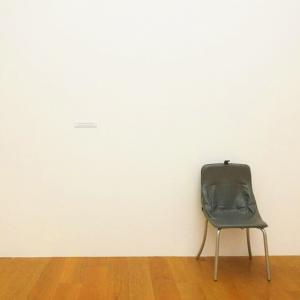
NULLA, Mambo
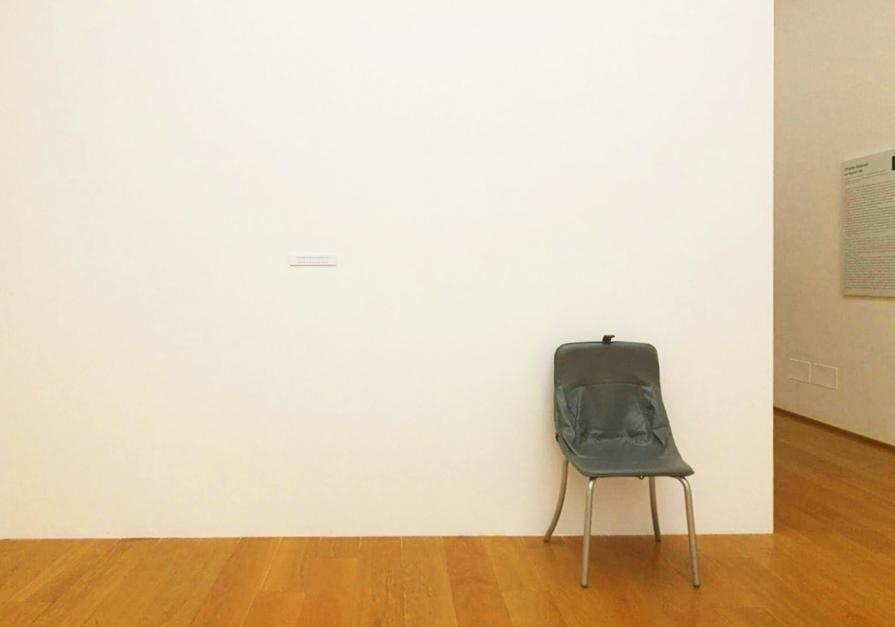
Nulla ( Nothing/ The Emptiness) ‘Nulla’ scares, ‘ Nulla’ opposed to being, it is all the things that it is not, and this is what scares, frightens. Mankind created the idea of nothing and gave it a name. Researches, scientists, people of faith spent all their lives in the desperate and distressing research of a link between nothing and reality. It is exactly with this idea that Dario Agrimi’s work of art ‘Nulla’ was conceived, to shape the shapeless, to associate a concept to the Nulla, overturning the conceptual logic in the term itself. We could have Nulla in our pockets, Nulla to say, think that there is Nulla more to do, but the effort that the author requires from us is way bigger that the concept of ‘absence’ or ‘neglect’, because it requires the ability of removing everything, thoughts included. Agrimi, with his work of art, allows the viewer to experience the Nulla, to ask himself what it is, without any influences derived from an artistic perception, without well-defined shapes or edges, without weight or specific consistency. The viewer is in front of the Nulla, he faces himself, his own corporeal experience, he looks at an unconditional possibility imposed by the impossibility itself of human kind’s absolute silence. We can experience, therefore, according to the artist, the presence as well as the absence and with it the maximum expressivity of the act, emerges out of emptiness, from an extremism of ‘Nulla’ that is the only element able to evoke the mystery of existence. When art neglects itself it expresses with the maximum intensity the sense and shape of its own origin, in that Nulla where everything is possible. ‘Nulla’ is an artwork exhibited at: Palazzo Strozzi (Florence, Italy, 2016); Mambo (Bologna, Italy, 2017); Artefiera (Bologna, Italy, 2017); Biennale di Venezia (Venice, Italy, 2017); Palazzo Grassi (Venice, Italy, 2017); Guggenheim Museum (Venice, Italy, 2017); Saatchi Gallery (London, UK, 2017); Tate Modern (London, UK, 2015); Tate Britain (London, UK, 2017); British Museum (London, UK, 2017); Louvre (Paris, France, 2017); Musée D’Orsay (Paris, France, 2017); Museo Blanco (Bali, Indonesia, 2016). The singularity, however, is that in all these sites a proper artistic operation was realised, with the main intent of completely overturn the artwork exhibitive sense. Agrimi, indeed, carrying out the performative act of pinning explicatory captions on the empty walls of the exhibitions, without any permission given by curators of these world-famous museums and galleries, shaped the undefined, forcing the curious viewer to ask himself questions about ‘Nulla’. The real revolution of this work is that today, without an actual acknowledgment, ‘Nulla’ is present in every museum and gallery of the world, but moreover, it is present in every place because is the concept of nothing itself that will bring every viewer back to Agrimi’s illumination. The latter is the person who now owns the deepest and most conceptual meaning of the term and who decided to dedicate one of his artworks to ‘Nulla’.
NULLA
‘Nulla’ scares, ‘ Nulla’ opposed to being, it is all the things that it is not, and this is what scares, frightens.
Mankind created the idea of nothing and gave it a name.
Researches, scientists, people of faith spent all their lives in the desperate and distressing research of a link between nothing and reality.
It is exactly with this idea that Dario Agrimi’s work of art ‘Nulla’ was conceived, to shape the shapeless, to associate a concept to the Nulla, overturning the conceptual logic in the term itself. We could have Nulla in our pockets, Nulla to say, think that there is Nulla more to do, but the effort that the author requires from us is way bigger that the concept of ‘absence’ or ‘neglect’, because it requires the ability of removing everything, thoughts included.
Agrimi, with his work of art, allows the viewer to experience the Nulla, to ask himself what it is, without any influences derived from an artistic perception, without well-defined shapes or edges, without weight or specific consistency.
The viewer is in front of the Nulla, he faces himself, his own corporeal experience, he looks at an unconditional possibility imposed by the impossibility itself of human kind’s absolute silence.
We can experience, therefore, according to the artist, the presence as well as the absence and with it the maximum expressivity of the act, emerges out of emptiness, from an extremism of ‘Nulla’ that is the only element able to evoke the mystery of existence.
When art neglects itself it expresses with the maximum intensity the sense and shape of its own origin, in that Nulla where everything is possible.
‘Nulla’ is an artwork exhibited at: Palazzo Strozzi (Florence, Italy, 2016); Mambo (Bologna, Italy, 2017); Artefiera (Bologna, Italy, 2017); Biennale di Venezia (Venice, Italy, 2017); Palazzo Grassi (Venice, Italy, 2017); Guggenheim Museum (Venice, Italy, 2017); Saatchi Gallery (London, UK, 2017); Tate Modern (London, UK, 2015); Tate Britain (London, UK, 2017); British Museum (London, UK, 2017); Louvre (Paris, France, 2017); Musée D’Orsay (Paris, France, 2017); Museo Blanco (Bali, Indonesia, 2016).
The singularity, however, is that in all these sites a proper artistic operation was realised, with the main intent of completely overturn the artwork exhibitive sense.
Agrimi, indeed, carrying out the performative act of pinning explicatory captions on the empty walls of the exhibitions, without any permission given by curators of these world-famous museums and galleries, shaped the undefined, forcing the curious viewer to ask himself questions about ‘Nulla’.
The real revolution of this work is that today, without an actual acknowledgment, ‘Nulla’ is present in every museum and gallery of the world, but moreover, it is present in every place because is the concept of nothing itself that will bring every viewer back to Agrimi’s illumination. The latter is the person who now owns the deepest and most conceptual meaning of the term and who decided to dedicate one of his artworks to ‘Nulla’.
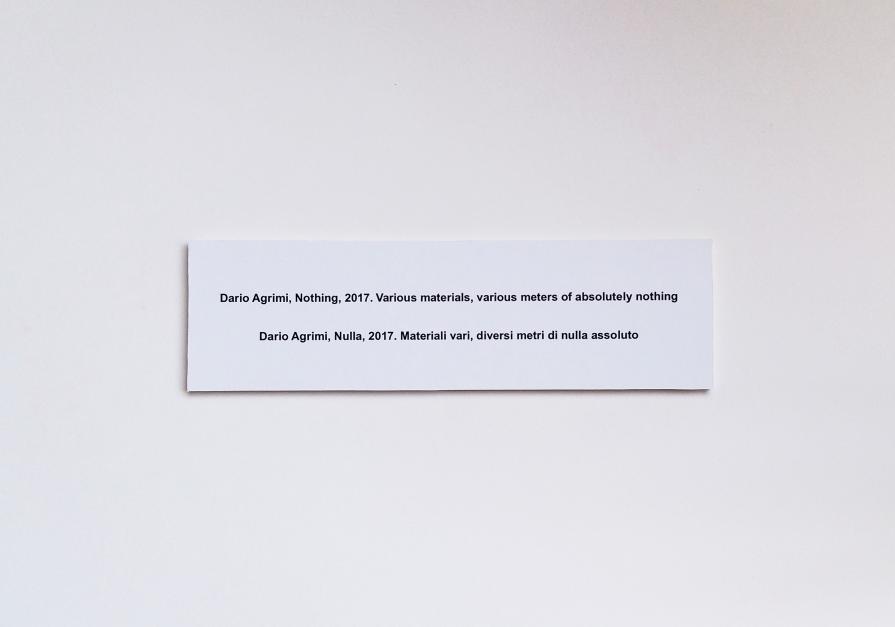













Comments 0
Say something